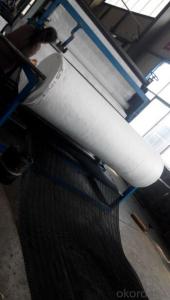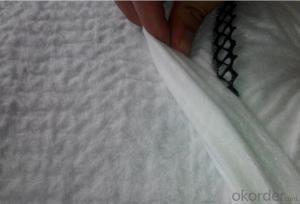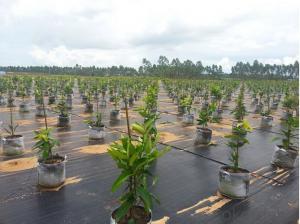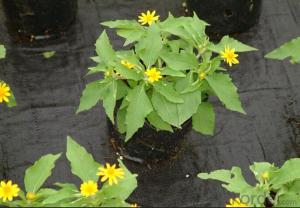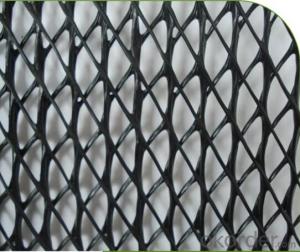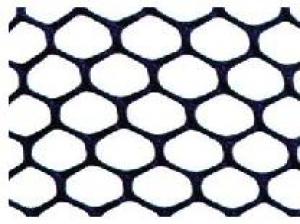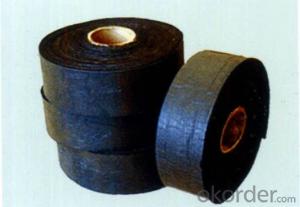Geonets/Geocomposite Drainage Liners for Erosion Control
- Loading Port:
- Qingdao
- Payment Terms:
- TT OR LC
- Min Order Qty:
- 2000 m²
- Supply Capability:
- 200000 m²/month
OKorder Service Pledge
OKorder Financial Service
You Might Also Like
Geonets/Geocomposite Drainage Liners for Erosion Control
Introduction
Geo-Net, also called drainage net, is a cost effective alternative to aggregate drains in containment systems. Geo-Nets take up less space than aggregate drains and can help to maximize volume in landfills and surface impoundments. Geo-Nets are commonly used between two geomembrane liners as part of a leak detection system. When placing Geo-Nets with geotextiles it is often effective to have the geotextile bonded to the Geo-Net in the factory. Geocomposites usually have a geotextile bonded to one, or to both sides of a Geo-Net. This creates a drainage structure that can be used between layers of geomembranes, and in many other unusual situations. The geotextile layers prevent the movement of soil fines into the Geo-Net drainage path that could lead to clogging and drainage failure.
Main features Geonet-Geotextile Drainage Geocomposite
1. Row water-borne strong (equivalent to one meter thick gravel drainage).
2. Tensile strength to be high .
3. Reduce geotextiles net core chance of embedded, maintain a long-term and stable drainage.
4. Long-term under great pressure and load (can bear about 3000Ka compression load)
5. Corrosion resistance, acid and alkali resistant, long service life.
6. Construction is convenient, shorten the construction period, lower cost.
8. Excellent drainage function, can bear long time high press road
9. High tensile and shear strength
10.Can bear more than 2000KPa compression load
11.anticompression capacity is much larger than common geonet for drainage.
Performance
1. Excellent drainage and sustain high compression loading
2. Highest tensile strength and shearing strength
3. Cut down ratio of geotextile into geonet and keep stable permeability in a long time
4. It can bear compression loading over 2000Kpa
5.Its compressive strength far exceeds general drainage geonet
Application
Using for drainage such as refuse landfill, roadbed & road surface, railway, tunnel, underground structure, retaining wall, garden, sports ground and so on.
Technical Data
Drainage network core | units | Specification | ||||
Unit weight | g/m2 | 750 | 1000 | 1300 | 1600 | |
Thickness | Mm | 5.0 | 6.0 | 7.0 | 7.6 | |
Hydraulic conductivity | m/s | kx10-4 | Kx10-4 | Kx10-4 | Kx10-4 | |
Elongation | % | 50 | 50 | 50 | 50 | |
Tensile strength (core netwaork) | kN/m | 8 | 10 | 12 | 14 | |
Geotextile | g/m2 | Heavier grades of geotextiles can be bonded to geonet on request | ||||
FAQ
1.How about the delivery time?
Lead time since receipt of 30% T/T deposit payment: 2-3 weeks. (Samples will be prepared within 3 days.)
2. What kind of payments does jenor support?
T/T, L/C, Cash are accepted.
3. What's are the MOQ?
We can according to your condition to set the MOQ. and we can provide you samples for quality inspection before the mass production.
4. Do you charge for the samples?
Accordeing to our company policy, the samples are free, we only charge the freight fee.
5. Can you produce according to customers' design?
Sure, we are professional manufacturer, OEM and ODM are both welcome.
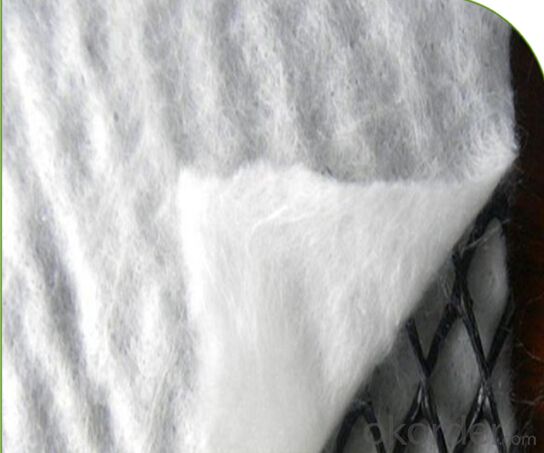
- Q:Can geosynthetics be used for lining hydraulic fracking ponds?
- Yes, geosynthetics can be used for lining hydraulic fracking ponds. Geosynthetics, such as geomembranes, are often used to provide a barrier between the pond and the surrounding environment. They can effectively prevent the seepage of fluids, contaminants, and chemicals, ensuring the protection of groundwater and soil. Geosynthetics also offer durability, flexibility, and resistance to punctures, making them suitable for the demanding conditions of hydraulic fracking operations.
- Q:How do geotextile bags compare to other erosion control methods?
- Geotextile bags, also known as geobags, have several advantages over other erosion control methods. Firstly, they are cost-effective and easy to install, requiring minimal labor and equipment. Additionally, geotextile bags provide excellent erosion resistance and stabilization, preventing soil loss and promoting vegetation growth. They are highly versatile and can be used in various applications, including slope protection, riverbank stabilization, and coastal erosion control. Furthermore, geotextile bags have a long lifespan and are environmentally friendly, as they are made from durable and biodegradable materials. Overall, geotextile bags offer a reliable and efficient erosion control solution compared to other methods.
- Q:How do geosynthetic meshes help in soil reinforcement?
- Geosynthetic meshes help in soil reinforcement by providing a strong and stable layer that distributes forces and reduces soil movement. These meshes act as reinforcement elements, increasing the overall strength and stability of the soil structure. They prevent soil erosion, improve load-bearing capacity, and enhance slope stability, making them an effective solution for various civil engineering applications such as retaining walls, embankments, and road pavements.
- Q:Civil engineering materials stone test, the determination of stone grade with what practical significance?
- Adjust the proportion of sand, stone
- Q:What are the benefits of using geocells in erosion control projects?
- One of the main benefits of using geocells in erosion control projects is their ability to provide structural support and stability to the soil. Geocells are typically made of high-density polyethylene and are filled with soil or aggregate material. When placed on slopes or along riverbanks, they prevent erosion by confining the fill material and increasing its resistance to movement. Additionally, geocells allow for vegetation growth, reinforcing the natural ecosystem while minimizing the environmental impact of erosion control measures.
- Q:How can geocells be used in green wall systems?
- Geocells can be used in green wall systems as a reinforcement solution for retaining soil and supporting plant growth. The cellular structure of geocells provides stability and prevents soil erosion, allowing for vertical gardens to be created on walls or other vertical surfaces. By confining the soil within the cell walls, geocells enhance the structural integrity of the green wall system and promote healthy plant growth.
- Q:What is the purpose of using geocomposites in landfill leachate collection systems?
- The purpose of using geocomposites in landfill leachate collection systems is to enhance the efficiency and effectiveness of leachate collection and management. Geocomposites, which consist of geotextiles and geomembranes, provide a barrier against the escape of leachate into the surrounding environment. They also help in promoting the flow of leachate towards collection pipes or drains, preventing clogging and ensuring proper drainage. Overall, geocomposites help to minimize the risk of contamination and facilitate the proper containment and disposal of leachate from landfills.
- Q:What are the different types of retaining walls?
- There are several different types of retaining walls including gravity walls, cantilever walls, sheet pile walls, anchored walls, and reinforced soil walls.
- Q:How do earthwork products contribute to air quality improvement?
- Earthwork products such as soil, plants, and mulch contribute to air quality improvement through various mechanisms. Soil acts as a natural filter, trapping pollutants and preventing them from entering the air. Plants absorb carbon dioxide and release oxygen through photosynthesis, thereby reducing the levels of greenhouse gases in the atmosphere. Additionally, trees and vegetation help mitigate urban heat island effect, reducing energy consumption and air conditioning needs, which in turn decreases the emission of air pollutants from power plants. Furthermore, the use of mulch can help minimize soil erosion and dust generation, preventing particulate matter from polluting the air. Overall, earthwork products play a crucial role in enhancing air quality and creating healthier environments.
- Q:Can earthwork products be used for creating artificial waterfalls?
- Yes, earthwork products can be used for creating artificial waterfalls. Earthwork products such as rocks, boulders, and soil can be strategically placed to construct the structure and shape of the waterfall. Additionally, these products can help in creating a natural-looking and aesthetically pleasing waterfall feature.
1. Manufacturer Overview |
|
|---|---|
| Location | |
| Year Established | |
| Annual Output Value | |
| Main Markets | |
| Company Certifications | |
2. Manufacturer Certificates |
|
|---|---|
| a) Certification Name | |
| Range | |
| Reference | |
| Validity Period | |
3. Manufacturer Capability |
|
|---|---|
| a)Trade Capacity | |
| Nearest Port | |
| Export Percentage | |
| No.of Employees in Trade Department | |
| Language Spoken: | |
| b)Factory Information | |
| Factory Size: | |
| No. of Production Lines | |
| Contract Manufacturing | |
| Product Price Range | |
Send your message to us
Geonets/Geocomposite Drainage Liners for Erosion Control
- Loading Port:
- Qingdao
- Payment Terms:
- TT OR LC
- Min Order Qty:
- 2000 m²
- Supply Capability:
- 200000 m²/month
OKorder Service Pledge
OKorder Financial Service
Similar products
New products
Hot products
Hot Searches
Related keywords
